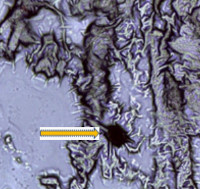Preliminary detection of Toxoplasma Gondii in Goats slaughtered at the Kumasi Abattoir.
https://dx.doi.org/10.4314/njpar.v43i2.4
Keywords:
Detection, Prevalence, Goat, Abattoir, ToxoplasmaAbstract
The protozoan Toxoplasma gondii is an obligate intracellular parasite that infects all homoeothermic animals, including humans. The study aimed to isolate T. gondiifrom the diaphragm of goats and to estimate the prevalence of T. gondiiinfection in goats at the Kumasi abattoir. A 2cm x 1cm sample was obtained from the skeletal muscle (diaphragm) of 100 goats slaughtered at the Kumasi abattoir. Samples were kept in 10% formalin, sectioned, deparaffinized, rehydrated, and stained with haematoxylin and eosin to identify onlyT. gondiitissue cysts, including bradyzoites and tachyzoites. The data obtained were entered into to Microsoft Excel spreadsheet (version 2016) and analysed using GraphPad Prism software (v. 9.2.0 (332). Results revealed Toxoplasma gondii present in slaughtered goats at a prevalence of 42%. Male animals (53.7%) were mostly affected byToxoplasma gondii as compared to the females (38.7%) at the Kumasi abattoir. Goats which were 2 years of age recorded a higher prevalence of 48.5% followed by goats within the age of 1 year (40.0%), 1 ½ year (36.4%) and 3 years (40.0%) whilst goats of 2 ½ years old recorded least prevalence (40.0%) of Toxoplasma gondii infection. The West African Dwarf goats (WADG) recorded a lower prevalence of 23% whilst the Sahelian breed of goats recorded a higher percentage prevalence of 29%. Nevertheless, breed (p=0.865), age (p=0.920) and sex (p=0.155) of goats did not have statistically
significant effects on the prevalence of T. gondii infection in goats. Institution of surveillance and reporting system for Toxoplasma gondii in goat populations in Ghana is recommended to stakeholders because of its public health importance.
References
European Food Safety Authority (EFSA) (2012). The European Union summary report on trends and sources of zoonoses, zoonotic agents and food-borne outbreaks in 2010.EFSAJ 10: 2597.
Audibert, M. (2008). Endemic diseases and agricultural productivity: Challenges and policy response. 2008.23. 2011.
Saeij, J. P., Boyle, J. P., Grigg, M. E., Arrizabalaga, G., and Boothroyd, J. C. (2005). Bioluminescence imaging of Toxoplasma gondii infection in living mice reveals dramatic differences between strains. Infection and immunity, 73(2),695–702.
Dubey, J. P., Lago, E. G., Gennari S. M., Su, C., and Jones, J. L. (2012). Toxoplasmosis in humans and animals in Brazil: high prevalence, high burden of disease, and epidemiology. Parasitology139: 1375–1424.
Ajzenberg, D., Cogné, N., Paris, L., Bessières, M. H., Thulliez, P., Filisetti, D., Pelloux, H., Marty, P., and Dardé, M. L. (2002). Genotype of 86 Toxoplasma gondii isolates associated with human congenital toxoplasmosis, and correlation with clinical findings. Journal of Infectious Diseases 186, 684–689.
Younis, E. E, Abou-Zeid, N. Z., Zakaria, M., and Mahmoud, M. R. (2015).Epidemiological studies on toxoplasmosis in small ruminants and equine in Dakahlia Governorate, Egypt. Assiut VeterinaryMedicine Journal. 61 (145) April 2015.
Dubey, J.P. (2010). Toxoplasmosis ofanimals and humans (2nd ed.). Boca Raton: CRC Press. p.17-231.
Gebremedhin, E. Z., Abebe, A. H., Tessema, T. S., Tullu, K. D., Medhin, G., Vitale, M. and Di Marco, V., (2013). Seroepidemiology of Toxoplasma gondiiinfection in women of child-bearing age in central Ethiopia. BMC Infectious Diseases, 13.
Tenter, A. M., Heckeroth, AR., and Weiss, L. M. (2000). Toxoplasma gondii: from animals to humans. International Journal Parasitology. 30: 1217–1258.
Frimpong, S., Bosona, T., Bobobee, E., Aklaku, E. and Hamdu, I. (2012). Animal Supply and Logistics Activities of Abattoir Chain in Developing Countries: The Case of Kumasi Abattoir, Ghana. Journal of Service Science and Management. 05. 10.4236
Asare, D. A., Emikpe, B. O., Folitse, R. D, and Burimuah, V. (2016). Incidence and pattern of pneumonia in goats slaughtered at the Kumasi Abattoir, Ghana. AfricanJournal of Biomedical Research, 19(1).
Terra, R. L, and Reynolds, J. P. (2020). Ruminant history, physical examination, welfare assessment, and records. Pages 2 – 13. In: SMITH, B. P. (Ed.). Large Animal Internal Medicine, Fourth Edition, Mosby St. Louis, Philadelphia, USA.
Cenci-Goga, T.B., Rossitto, P.V., Sechi, P., McCrindle, C.M.E., and Cullor, J.S.(2011). Toxoplasma in Animals, Food, and Humans: An Old Parasite of New Concern Foodborne Pathogens and Disease. Jul 2011.751-762.
Teshale, S., Dumetre, A., Darde, M.L., Merga, B., and Dorchies, P. (2007). Serological survey of toxoplasmosis in Ethiopia: prevalence and risk factors. Parasite. 14:155–159.
El Safadi, D., Abi Chahine, D., Al-Tarraf, A., Raii, O., Mesto, K., Ismail, M. B., and Hamze, M. (2019). First report on seroprevalence and risk factors of Toxoplasma gondii infection in sheep and goats in North Lebanon. Journal ofInfections in Developing Countries 13: 831-836.

Published
How to Cite
Issue
Section
License
Copyright (c) 2023 Nigerian Journal of Parasitology

This work is licensed under a Creative Commons Attribution-NonCommercial-NoDerivatives 4.0 International License.




